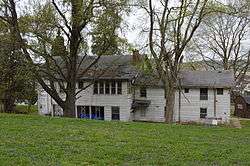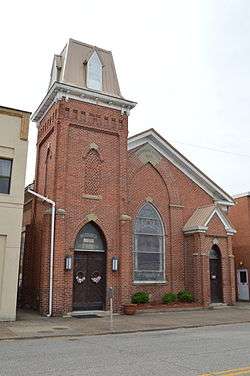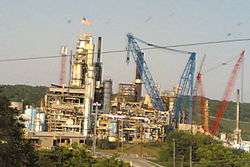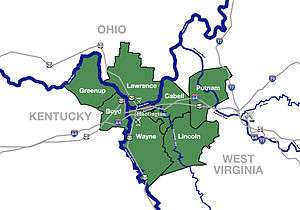Catlettsburg, Kentucky
| City of Catlettsburg, Kentucky | |
|---|---|
| City | |
|
Louisa Street in downtown Catlettsburg in 2007 | |
|
Location in the state of Kentucky | |
| Coordinates: 38°24′17″N 82°36′02″W / 38.40472°N 82.60056°WCoordinates: 38°24′17″N 82°36′02″W / 38.40472°N 82.60056°W | |
| Country | United States |
| State | Kentucky |
| County | Boyd |
| Government | |
| • Mayor | Randall Peterman |
| Area | |
| • Total | 1.7 sq mi (4.3 km2) |
| • Land | 1.3 sq mi (3.3 km2) |
| • Water | 0.4 sq mi (1.0 km2) |
| Elevation | 554 ft (169 m) |
| Population (2010)[1] | |
| • Total | 1,856 |
| Time zone | EST (UTC-5) |
| • Summer (DST) | EDT (UTC-4) |
| ZIP code | 41129 |
| Area code(s) | 606 |
| FIPS code | 21-13420 |
| GNIS feature ID | 0489094 |
Catlettsburg is a home rule-class city[2] in and the county seat of Boyd County, Kentucky, United States.[3] The city population was 1,856 at the 2010 census. Catlettsburg is a part of the Huntington-Ashland, WV-KY-OH, Metropolitan Statistical Area (MSA). As of the 2010 census, the MSA had a population 287,000.
Randall Peterman is the current mayor. Peterman, a city councilman who was appointed mayor in September 2011 to succeed the resigning Pauline S. Hunt, will serve until a special election can be called.
History
Early history

Catlettsburg's history begins in the decades directly following the American Revolution, as many frontiersmen passed through the area on their western trek along the Ohio River. Alexander Catlett, the first landowner of the area, came to the site in 1798. His son, Horatio Catlett opened a post office on December 5, 1810 with himself being the post master. This was the first known use of the name Catlettsburg being used officially as it had been previously known as Mouth of Sandy. In 1849, James Wilson Fry, landowner who purchased the site from the Catlett family in 1833, sold off town lots of what was soon to be the town of Catlettsburg. (The Kentucky Encyclopedia says the Catletts settled the area in 1798.[4]) and Catletts resided at the location until 1847. After establishing this settlement, the Catletts operated a business that consisted of a tavern, post office, trading post, and inn, out of a log structure they built from virgin timber about 1811. Due to its location along the route of the American frontier, the Catletts provided hospitality to such notable patrons as General Stonewall Jackson, Henry Clay, Felix Grundy, and future U.S. President James Garfield. Catering to the ever-growing river traffic, the Catlett business flourished and the present-day town grew up around it. Collis P. Huntington operated the Chesapeake and Ohio Railway. It's line to Cincinnati was built from Huntington in 1888. This required the construction of the railroad bridge that crosses the Big Sandy River at Catlettsburg, which carries an average of 80 trains daily.
The Catlett House is still standing two hundred years later and has long been used as the "servants' quarters" of Beechmoor Place, a large home located on Walnut Street (U.S. Routes 23 and 60). C.W. Culver bought the property from the Catlett heirs and built a large home of the Georgian style on the right of the Catletts' original dwelling. About 1868, Col. Laban T. Moore bought the estate from C.W. Culver for $10,000 ($171,000 in 2011). Col. Moore was noted as a former member of the U.S. House of Representatives and had previously served as a captain in the Kentucky Volunteer Infantry. He named his home Beechmoor, a portmanteau of his surname and that of a magnificent beech that stood on the fertile grounds at the time. Ownership of Beechmoor has remained in the Moore family since 1868. Beechmoor's eastern wing, being 200 years old and built by the Catletts, is cited as the oldest known building in a 300-mile radius. Built of Kentucky's virgin hemlock maple (now virtually extinct), the exterior walls are between 9 and 12 inches thick. The main portion has a stone foundation, and is held up by the same virgin timber, each 64 feet (20 m) in diameter, and running the entire 42-foot (13 m) width of the house. Beechmoor's last full-time resident, Rebecca Patton, Col. L.T. Moore's granddaughter, was dedicated to Beechmoor's preservation during her lifetime. In 1973, she had her lifelong home listed on the National Register of Historic Places and made provisions to ensure the home would be maintained in the event of her demise. She died in 1986. Since then, it has been maintained by proceeds from a trust fund and rental property income. A paid caretaker lives on the property full-time as of 2011. Several attempts have been made by local civic groups to acquire the property as a museum or civic use property due to its historical significance to the area but have not been successful as of this time, due to the family's desire to retain ownership.

The Catlett name is still used on a tributary to the Ohio River, Catlett's Creek, which follows Kentucky Route 168 for many miles west of the city. Catlettsburg annexed two nearby communities on its borders in the late 19th century: Hampton City to the south side and Sandy City to the north.
The spelling of the city's name was changed to Catlettsburg from the previous spelling of Catlett's Burg c. 1890.
Catlettsburg served as a Union Army supply depot during the Civil War. The First Presbyterian Church, 26th and Broadway, served as an army hospital during the war. The church building still serves the congregation of the Presbyterian church in Catlettsburg. The current church, built in 1875, is one of two truly gothic buildings still standing in the U.S. The church is of mid-to-late 19th century Grecian design, with most original fixtures in place. It is often used for wedding ceremonies because of its beauty. The Catlettsburg National Bank building used to sit at the corner of Center and Division/26th streets was listed on the National Register, but has been demolished due to the structure being unstable.
Beginning in the late 19th century and lasting until the early 1920s, Catlettsburg was the largest hardwood timber market in the world due to its location at the mouth of the Big Sandy River. Due to the profitability of harvesting such hardwoods, most all virgin timber that existed for several miles around Catlettsburg was felled during that period. Very few trees of desirable breeds such as oak were left standing once the boom was over, mostly to mark private property lines. One known exception to history's hardwood harvest is the existence of a large oak, standing on a knob in the Hampton City section. With its origins dating to circa 1760, it measures 246 inches (6.2 m) in diameter. It is the oldest known living tree of any breed within the city limits and for many miles surrounding the city. There is also a hemlock maple tree (which measures over 350 inches in diameter) located on the same property, one of very few that remain in North America as they were all but extinct due to their heavy usage in home construction from 1750-1925.

Rail transportation began to slowly replace the river's prominence as a mode of transportation as the Chesapeake & Ohio (C&O) railroad began construction of a bridge across the Big Sandy River linking Catlettsburg with Kenova, West Virginia in 1885. The bridge is still traversed by trains many times each day, as a part of CSX Transportation's (formerly C & O Railway) main operations. Known by railroad enthusiasts and historians from around the world, it is unique in design and historic value for its longevity. The bridge is also used by Amtrak's Cardinal passenger train, train numbers 50 (eastbound, toward Huntington) and 51 (westbound, toward Ashland), which carries passengers from Chicago to New York City. The Chatteroi railroad preceded the C & O by a few years as the first rail line to travel through Catlettsburg's city limits, as it followed the Big Sandy River north from the coal fields to Ashland.
The Chesapeake & Ohio Railway built a passenger depot in Catlettsburg in 1906 and operated the facility for over 52 years until 1958 when passenger service was transferred to nearby Ashland. After closing the facility, C & O sold it to the city of Catlettsburg for $1. The city has maintained it and used it as a civic center since that time. In 2006, longtime Catlettsburg businessman and politician Russell Compton donated his own personal funds for the restoration of the train depot so it could be restored to its original appearance. Intensive restoration of the depot is now complete, featuring the original directional signage, etc. The facility was renamed the Russell Compton Community Center in 2007 in his honor. In 2010, Compton donated the necessary funds to restore an old C & O caboose to its original appearance. It is now parked on the side of the depot facility.
Modern history

At the turn of the 20th century, Catlettsburg was the largest hardwood timber market in the world, due to its location at the confluence of the Big Sandy and Ohio rivers. Its population has declined considerably since then, once nearing 10,000 residents, but still serves as a trade center for eastern Boyd County.
It is home to some of the oldest continually-operating businesses in the area. Bowling's Feed and Hardware Store, Craycraft's Foodland Supermarket and Kentucky Farmers Bank have all been in business continually for over 60 years. Kilgore and Collier Funeral Home on Panola Street is the oldest business in Boyd County, with over 130 years of continual operation in the same location. In October 1997, the Catlettsburg Youth/Family Area Resource group was established with a grant obtained from the hard work of the local 4-H director, Suellen Zornes. Its name was later changed to the Catlettsburg Development Club, then to Catlettsburg Main Street Association. Since its inception, the association can be credited with the development of the flood wall murals and other improvements throughout the city.
The flood wall and grass levees that surround downtown and most residential areas were constructed in 1951 to relieve the city of constant flood damage. Longtime Catlettsburg lawyer, then the city's attorney James Adkins Sr. traveled to Washington D.C., where he went before Congress with a plea for flood protection assistance. A large portion of the city is located in a ten-year flood plain; Mr. Adkins' efforts, along with other factors prompted the U.S. Army Corps of Engineers to construct the flood wall and levee around the flood plain. As it was much needed at the time, the initial construction mandated the removal of over 500 residential homes, which reduced the city's population by over 1,000 immediately. Since construction was complete, no major flooding has occurred in the area protected by the flood wall and levee.

The city has prospered in later years from its location on two federal highway routes: U.S. Routes 23 and 60. Since the inception of the Federal Highway system in 1926, both routes have gone through the city limits, first using surface streets and now a four-lane highway directly west of the downtown business district. When the completion of the U.S. 23 widening project was completed in 1971, through traffic was then re-routed around downtown and the original business district suffered from decline. By the early 1990s, much of the business district had moved onto the newer four-lane U.S. 23. At the project's inception, Catlettsburg officials were concerned with future increased costs to the city for maintaining the former state roads. They requested that Route 60 remain on its original 1926 downtown route, also requesting that the old U.S. 23 be re-designated as U.S. 23 business. Both wishes of the city were granted and U.S. 60 remained on the downtown routing. U.S. 23 became U.S. 23 Business. In November 1990, all U.S. 60/U.S. 23 business signage was removed from the original routes. From then on U.S. 60 follows 35th Street from the bridge, turns right onto U.S. 23 and follows it through the city limits to Ashland. When signage for U.S. 23 Business and U.S. 60 were finally removed from downtown, the entire stretch from 36th Street to the last underpass was signed as Ky. Route 3294. This decision was made by the Kentucky Department of Highways in 1987, when a new U.S. 60 bridge to Kenova, West Virginia was completed across the Big Sandy River accessed from 35th Street instead of the old 34th Street approach. The road leading to the old bridge remains under maintenance of the state from the old bridge ramp to Court Street, formerly U.S. Route 60 until 1987, and the state continues to maintain it to this day but it is unsigned as a state highway.
The topography of this city is a combination of flat land along the rivers, then steep hillsides with rock cliffs to the western edge of the city limits. A few neighborhoods are located on the hilltops. The rugged terrain provides some breathtaking views from the hills overlooking town, but has also restricted residential housing growth within the city limits. Most of the undeveloped land in the city is steep hill sides and cliffs, which is not conducive to any significant development. Many historic buildings can be found in the city limits, mostly dating from the mid-to-late 19th century. The structural base of the city, mainly centered on the downtown area, was constructed during the hardwood boom of the late 19th century and is of brick/stone, or hardwood construction.
In addition to the re-designation of U.S. 23 and U.S. 60 in the 1970s and 1980s, the downtown business district received another decrease in traffic when the Federal courthouse was relocated from downtown Catlettsburg to a new home in Ashland in 1985. For 74 years, it had used the upper floors of the Catlettsburg post office on 25th Street. The large stone building still bears the description etched in stone-"U.S. Post Office and Courthouse". In 1998, a new post office was built on U.S. 23, south of downtown which gave another blow to the central business district. The population within the city limits has been in decline since 1930, mainly due to "urban sprawl" syndrome found in older cities across the U.S. Most significant housing construction has occurred outside the city limits since that time. The last annexation of land area occurred in the 1970s, when 10 homes in the Brumfield Estates addition were annexed into the city. With little annexation into the city limits, and business growth replacing many residential zones within the city, a decrease in population has occurred. The biggest declines in population occurred from 1960 to 1970 and 1980 to 1990. The biggest factor in this decline was the widening of U.S. 23 to a four-lane highway which resulted in the removal of several hundred residential dwellings in the 1960s and 1970s. Then beginning in the mid-1980s, many residential zones were removed and replaced with commercial zones, thus removing residents again.
About the area

Catlettsburg is located in the northeast corner of Kentucky at the confluence of the Ohio and Big Sandy rivers. It is considered part of the Kentucky, West Virginia, and Ohio "Tri-state area". The two most significant landmarks in Catlettsburg are the flood wall and the Catlettsburg Refinery. The latter is owned by Marathon Petroleum Company (formerly Ashland, Inc., then Marathon Ashland Petroleum, LLC).
In 1937, a large snowfall and subsequent rainfall in the mountains of West Virginia swept massive amounts of water into the Ohio River. Catlettsburg was completely inundated with water from this runoff, and what would later be called the 1937 Flood convinced Ashland, Ironton, Catlettsburg and Russell that they needed permanent flood protection.
The flood wall/levee was completed in 1951, constructed by Federal funds with assistance from the Army Corps of Engineers and the Works Progress Administration.
Catlettsburg is home to the Catlettsburg Refinery, which is owned by Marathon Petroleum Corporation. It was purchased in 1924 by Swiss Oil Corporation (then parent company of Ashland Inc.) and became fully owned by Marathon in 2005. The refinery sits on a 650-acre (2.6 km2) site, has a capacity of 212,000 barrels (33,700 m3) per calendar day and is staffed by more than 800 employees.
The ISO 9001-2000 approved refinery processes a wide range of sweet and sour crudes, both imported and domestic. The product mix includes gasoline, diesel fuel, kerosene, jet fuel, asphalt, propane, propylene, heavy oil (predominately slurry), cumene, toluene, xylene, sulfur and dilute naphthalene oil. The refinery produces low sulfur gasoline and ultra-low sulfur diesel (ULSD).
The facility has a rich tradition extending back to the 1920s. Ashland Refining Company purchased the 1,000 barrels per day (160 m3/d) plant in 1924, when it was little more than a skimming operation from which a few products were distilled. Partially built to assist the World War II industrial effort, the Catlettsburg Refinery is a landmark for what is commonly known as the "Tri-State area," connecting Kentucky, West Virginia and Ohio. With its strong commitment to technology, safety and its employees, the refinery soon became one of the most modern and efficient in the nation.
Geography
Catlettsburg is located 38°24′59″N 82°36′10″W / 38.41639°N 82.60278°W (38.416273, -82.602762).[5]
According to the United States Census Bureau, the city has a total area of 1.6 square miles (4.1 km2), of which 1.3 square miles (3.4 km2) is land and 0.4 square miles (1.0 km2) (22.42%) is water.
Demographics
| Historical population | |||
|---|---|---|---|
| Census | Pop. | %± | |
| 1870 | 1,019 | — | |
| 1880 | 1,225 | 20.2% | |
| 1890 | 1,374 | 12.2% | |
| 1900 | 3,081 | 124.2% | |
| 1910 | 3,520 | 14.2% | |
| 1920 | 4,183 | 18.8% | |
| 1930 | 5,025 | 20.1% | |
| 1940 | 4,524 | −10.0% | |
| 1950 | 4,750 | 5.0% | |
| 1960 | 3,874 | −18.4% | |
| 1970 | 3,420 | −11.7% | |
| 1980 | 3,005 | −12.1% | |
| 1990 | 2,231 | −25.8% | |
| 2000 | 1,960 | −12.1% | |
| 2010 | 1,856 | −5.3% | |
| Est. 2015 | 1,808 | [6] | −2.6% |
As of the census[8] of 2000, there were 1,960 people, 827 households, and 519 families residing in the city. The population density was 1,528.8 people per square mile (591.2/km²). There were 959 housing units at an average density of 748.0 per square mile (289.3/km²). The racial makeup of the city was 98.16% White, 1.12% African American, 0.20% Native American, 0.05% from other races, and 0.46% from two or more races. Hispanic or Latino of any race were 0.10% of the population.
There were 827 households out of which 23.9% had children under the age of 18 living with them, 45.0% were married couples living together, 13.3% had a female householder with no husband present, and 37.2% were non-families. 34.0% of all households were made up of individuals and 17.0% had someone living alone who was 65 years of age or older. The average household size was 2.25 and the average family size was 2.85.
In the city the population was spread out with 20.4% under the age of 18, 10.4% from 18 to 24, 28.1% from 25 to 44, 24.2% from 45 to 64, and 16.9% who were 65 years of age or older. The median age was 38 years. For every 100 females there were 94.8 males. For every 100 females age 18 and over, there were 92.7 males.
The median income for a household in the city was $24,167, and the median income for a family was $34,118. Males had a median income of $26,683 versus $24,107 for females. The per capita income for the city was $13,682. About 15.1% of families and 21.6% of the population were below the poverty line, including 28.3% of those under age 18 and 16.7% of those age 65 or over.
Education
The Catlettsburg Independent School district was merged with the Boyd County School District in 1974. Until that time, the city had three elementary schools serving grades K-8 and one high school. After the merger, the Catlettsburg High School campus, which was built in 1965, became Catlettsburg Junior High, serving grades 7-9. Haney Elementary was closed and students then attended Yost Elementary. Hatfield Elementary remained open. At the close of the 1979-80 school year, Yost Elementary was closed and students were transferred to Hatfield, where a new school building replaced the former. It was then renamed Catlettsburg Elementary. At the time of its closing in 1980, Yost Elementary School was the oldest operating school building in the state of Kentucky and one of the oldest in the United States. It was first constructed in 1894 as the Catlettsburg Public School and served all twelve grades for many years before becoming a grade school. Students in grades 10-12 were transferred to Boyd County High School in 1974. At the end of the 1992-93 school year, the junior high was merged with Summit Junior High (now Boyd County Middle School). Since then, Catlettsburg Elementary has been the only school within the city limits, and uses the campus of the former high school/jr. high school at 3380 Court Street. The gymnasium of Catlettsburg Elementary was built many years before the school buildings that surround it. Part of the New Deal, it was constructed by the Works Progress Administration in 1935. The Catlettsburg High School was added onto it in 1965, and now serves as the elementary school's gymnasium, which hosts many civic events such as the Catlettsburg Miss Flame Pageant that feeds into the Miss Kentucky Pageant and Miss America system. In 1991, Ponderosa Elementary School began educating students when it was constructed at Ponderosa Estates.
Notable people
- Nannie Scott Honshell, ironmaster was born here
- Billy C. Clark, nationally recognized author of numerous novels including Goodbye Kate, which had its rights sold to The Walt Disney Company
- Michael Polakovs, the clown who revamped the Ronald McDonald character, lived in this area.[9]
See also
References
- ↑ "2010 Census Redistricting Data (Public Law 94-171) Summary File". American FactFinder. United States Census Bureau. Archived from the original on 21 July 2011. Retrieved 9 August 2012.
- ↑ "Summary and Reference Guide to House Bill 331 City Classification Reform" (PDF). Kentucky League of Cities. Retrieved December 30, 2014.
- ↑ "Find a County". National Association of Counties. Archived from the original on 2011-05-31. Retrieved 2011-06-07.
- ↑ Kentucky Encyclopedia, John E. Kleber, Editor in Chief, University of Kentucky Press 1992 p.170
- ↑ "US Gazetteer files: 2010, 2000, and 1990". United States Census Bureau. 2011-02-12. Retrieved 2011-04-23.
- ↑ "Annual Estimates of the Resident Population for Incorporated Places: April 1, 2010 to July 1, 2015". Retrieved July 2, 2016.
- ↑ "Census of Population and Housing". Census.gov. Archived from the original on May 11, 2015. Retrieved June 4, 2015.
- ↑ "American FactFinder". United States Census Bureau. Archived from the original on 2013-09-11. Retrieved 2008-01-31.
- ↑ Hart, Kenneth (2009-12-07). "Michael Polakovs, a.k.a. Coco, dies at 86". Daily Independent (Ashland, KY). Retrieved 2010-10-01.



